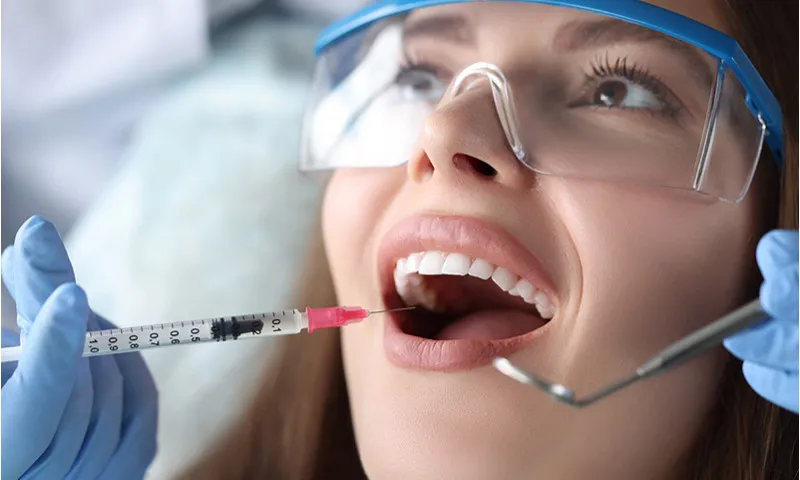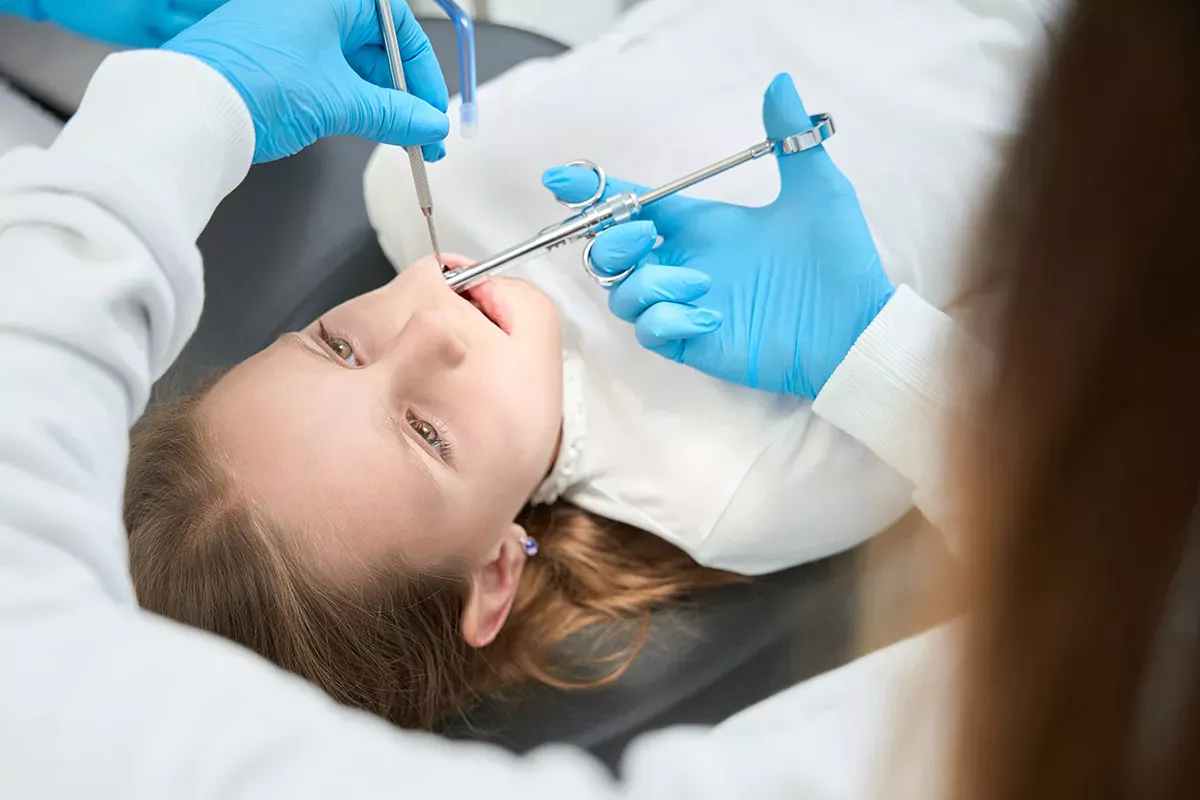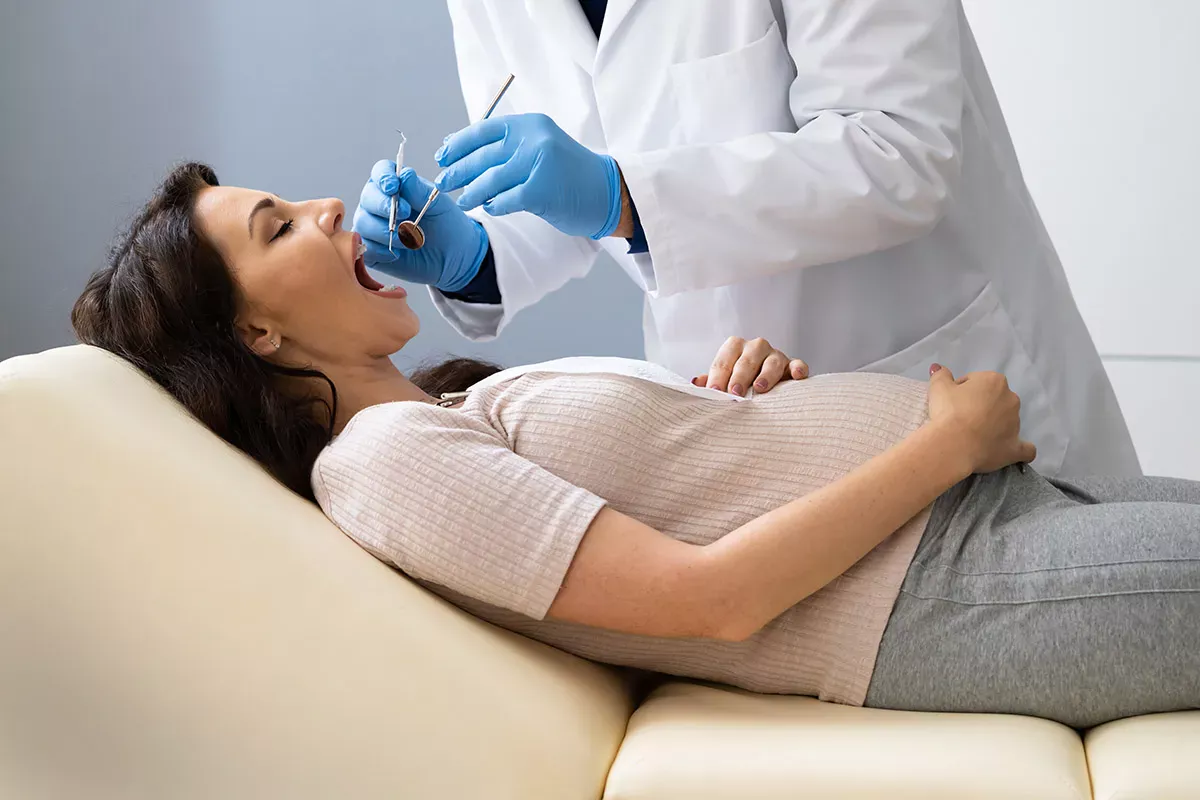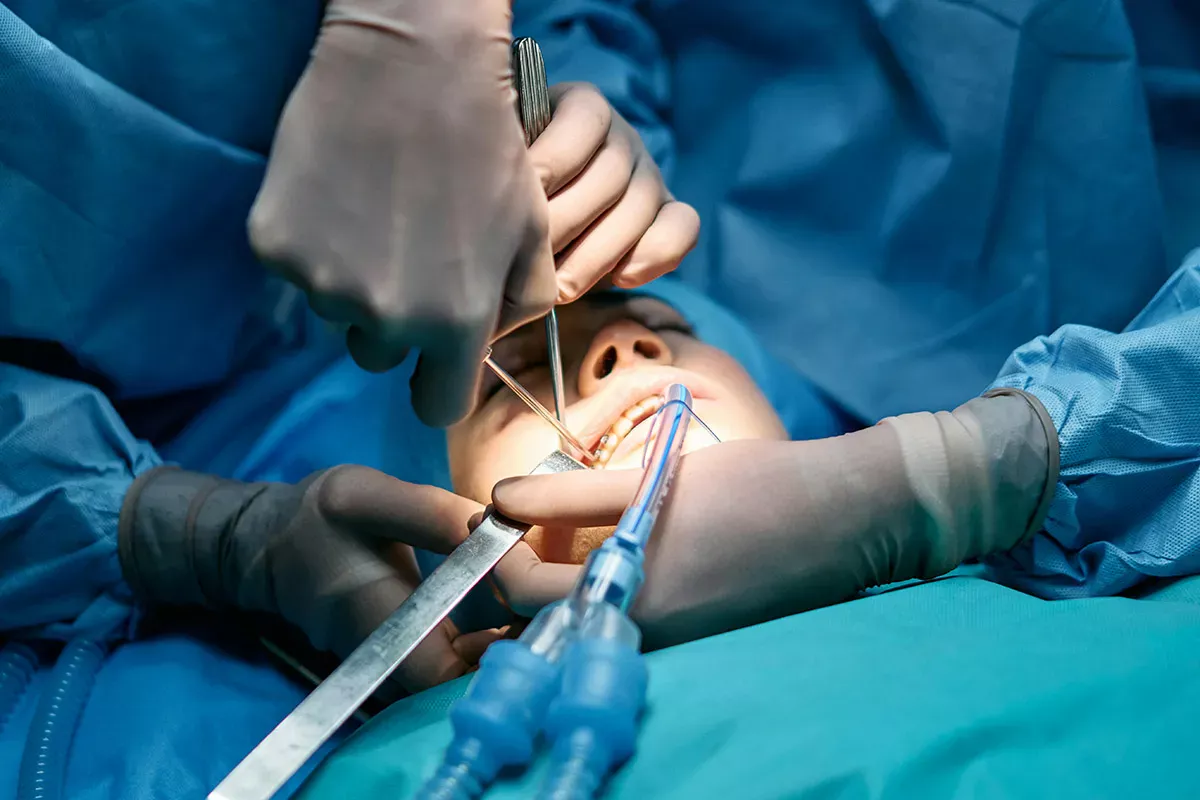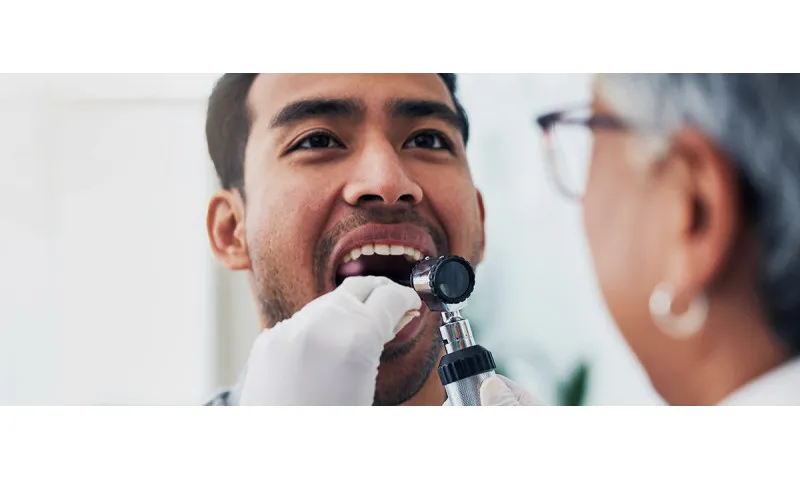Overview of anaesthesia methods at the dentist
The standard for most dental treatments is local anaesthesia (technical term: local anaesthetic). Even complex procedures such as root canal treatments, the extraction of wisdom teeth or the insertion of implants are now possible without pain using a local anaesthetic. Local anaesthesia is well tolerated and reliable. Side effects rarely occur.
Stronger anaesthetics are only necessary if the patient is afraid of the treatment or is unable to cooperate, which may be the case with children or people with disabilities, for example.
The following anaesthetic methods can then be used:
- Nitrous oxide
- Twilight sleep
- General anaesthesia
- Hypnosis
In this article, we will first take a look at the various local anaesthetic techniques and answer common questions before going into more detail about the alternatives for anxious patients.
How does local anaesthesia work at the dentist?
To understand how anaesthesia works at the dentist, we first need to understand what pain is and how it arises. There are three main players in this process: the receptors, the nerve pathways and the brain. When the receptors are irritated, they send pain signals to the brain via the nerve pathways. This can be caused by a hot or cold stimulus, for example, or by a mechanical stimulus such as drilling. The brain decodes the signals and makes us feel pain. What we perceive as extremely unpleasant is actually an ingenious protective function: the brain signals to us that there is danger.
However, when we undergo dental treatment - more or less voluntarily - we naturally want to bypass this natural protective mechanism. The aim of local anaesthesia is therefore to interrupt this chain reaction. If the pain signal does not reach the brain, we do not feel any pain. In order to achieve this, an active substance is injected that briefly interrupts the stimulus conduction.
Various local anaesthesia techniques
Different anaesthetic techniques are used depending on which part of the mouth is to be anaesthetised. In general, local anaesthesia can be used to numb the following areas:
- Teeth
- Gums
- Pine
- Lips
- Tongue
- Cheeks
- Mouth bottom
Surface anaesthesia
Surface anaesthesia is applied directly to the oral mucosa or gums in the form of sprays, gels or ointments to numb the tissue. Dentists use this form of local anaesthetic, especially for children and pain-sensitive adults, to make injecting the actual anaesthetic completely pain-free. After a few minutes, the anaesthetic takes effect and the dentist can give the injection without the person being treated feeling a prick. Surface anaesthesia therefore takes away the fear of the anaesthetic injection, but is not suitable for the actual anaesthetisation of teeth and gums during dental treatment.
Infiltration anaesthesia
Infiltration anaesthesia is mainly used in the upper jaw, but also for the front teeth in the lower jaw. The dentist injects the anaesthetic directly under the mucous membrane in the area to be treated. From there, it anaesthetises the surrounding area of teeth, tooth roots and bone, as well as the covering soft tissue and facial skin. Patients only feel the anaesthetic in the form of numbness in the area that is actually being treated. The anaesthetic numbs the receptors and prevents the pain signals from being transmitted to the brain. This anaesthetic method is only suitable for areas with a loose bone density and can therefore not be used in the lateral lower jaw.
Conduction anaesthesia
Conduction anaesthesia is usually used for dental treatments in the lateral lower jaw. Instead of anaesthetising a specific area as with infiltration anaesthesia, the dentist injects the anaesthetic near the nerve that supplies the respective half of the lower jaw and thus anaesthetises the entire half of the lower jaw. Patients then feel the typical numbness in the lower lip as well as in the tongue and in the respective cheek and chin area.
Intraligamentary anaesthesia
With intraligamentary anaesthesia, the dentist uses a syringe with a very thin needle and injects the anaesthetic directly into the gap between the tooth and the bone. This method can be used for procedures that are limited to a single tooth or as an additional anaesthetic if another form of anaesthesia is not effective enough.
Procedure for local anaesthesia
Depending on whether the dentist uses a surface anaesthetic, the local anaesthetic consists of three or four steps:
- Application of the surface anaesthetic
- Puncturing the skin with the needle tip
- Positioning the needle tip
- Injecting the anaesthetic
While many people are afraid of puncturing the skin, it is actually more common to experience pain or a feeling of pressure when injecting the anaesthetic. The slower the anaesthetic is injected, the less discomfort there is. The anaesthetic takes effect within a few minutes of injection. Only then does the treatment begin.
How long does the anaesthetic last at the dentist?
The duration of the local anaesthetic depends on the dose, technique and rate of decomposition of the patient. For example, the effect of conduction anaesthesia in the lower jaw lasts longer than infiltration anaesthesia in the upper jaw.
The following guide values apply:
- Surface anaesthesia: a few minutes
- Infiltration anaesthesia: 30 minutes to two hours
- Conduction anaesthesia: one to four hours
When the anaesthetic wears off, the sensation returns first to the teeth and jaw area and then to the tongue, lips and cheeks.
When can I eat again after the local anaesthetic at the dentist?
How long you are not allowed to eat after the anaesthetic at the dentist also depends on the anaesthetic method. You should not eat anything while the anaesthetic is working because you could accidentally bite your lips, cheeks or tongue or scald yourself with hot food and drink. Therefore, you should definitely eat before the anaesthetic so that you don't get hungry when the anaesthetic wears off. This is particularly important for diabetics.
What if the anaesthetic doesn't work?
It is very rare that the anaesthetic does not work at the dentist. This may be due to the fact that the active substance does not work on the patient or that the nerve pathways run in an unusual way. It is also possible that the dentist made a mistake when positioning the needle tip. In such cases, the dentist can insert another syringe and anaesthetise it again.
Does the anaesthetic at the dentist hurt?
Without prior surface anaesthesia, you can expect a small prick and a slight feeling of pressure when the anaesthetic is injected. However, dentists report that patients experience very different levels of pain. If you know that you are sensitive to pain, you should let your dentist know. They can then use a surface anaesthetic to make the injection pain-free.
Is it possible to accelerate the reduction of anaesthesia with home remedies?
There are no known home remedies that shorten the duration of the anaesthetic. However, some sufferers have found that drinking plenty of fluids helps to break down the anaesthetic.
However, if you need to be completely fit again quickly after the anaesthetic, you can have the dentist inject you with a special agent after the treatment that accelerates the breakdown of the anaesthetic. The anaesthetic will then wear off after around 30 minutes.
What to do if the anaesthetic doesn't go away after a visit to the dentist?
If the anaesthetic does not go away after the dentist, there is no need to worry. It may well take several hours for the numbness to wear off - especially with conduction anaesthesia of the lower jaw. It is best to drink plenty of fluids and rest. If the numbness still persists the next day, you should contact your dentist.
Good to know:
You should not drink alcohol or smoke after anaesthesia, as this has a negative effect on blood circulation and makes it harder for the anaesthetic to be removed.
Can I drive after the anaesthetic at the dentist?
In Germany, there is no general driving ban after a local anaesthetic at the dentist because the effect on driving ability can vary greatly depending on the medication administered, the dose and the patient's reaction. It is best to seek advice from your dentist as to whether or not you can drive again immediately after the procedure.
It is generally recommended that you refrain from driving for a few hours, as your ability to react may be impaired by the anaesthetic. It can take up to 24 hours for the anaesthetic to wear off completely. However, most people feel fit again much sooner.
Can I do sports after the anaesthetic at the dentist?
If the anaesthetic has already worn off and you feel fit, there is no reason not to exercise. However, if you feel limp and weak, you should take it easy.
Possible side effects of local anaesthesia
In addition to the typical numbness, the following side effects can occur with local anaesthesia at the dentist:
- Tiredness
- Lack of concentration
- Dizziness
- Headache
- Reduced responsiveness
- Temporary restriction of movement
- Temporary "crooked lip"
- Pain at the injection site
- Self-injury to the anaesthetised area (e.g. by biting the lower lip or cheek)
- Prolonged but temporary numbness if a nerve has been hit (Lingual nerve or mandibular nerve)
- Allergic reactions (e.g. skin rashes, itching, palpitations, nausea, swelling of the lips)
Anxiety patients in particular may also experience symptoms that are not directly related to the anaesthetic, but are rather triggered by psychological stress. These include, for example, diarrhoea and other stomach problems, but also confusion, nervousness and fluctuations in blood pressure.
What should I bear in mind if I have a pre-existing condition?
To avoid possible interactions, you should always inform the dentist about any allergies and previous illnesses as well as any medication you regularly take before treatment. This is the only way the dentist can determine which anaesthetic is right for you.
Here we have summarised for you which active ingredients could lead to complications and how you can avoid this:
Adrenalin
Many anaesthetics contain the active ingredient adrenaline to intensify and prolong the effect of the anaesthetic. At the same time, the blood vessels are constricted, which reduces blood flow in the treated tissue. Adrenaline therefore has definite advantages in local anaesthesia. However, anaesthetics containing adrenaline can cause side effects in some patients. This is why there are also local anaesthetics without adrenaline.
The following patients should avoid anaesthetics with adrenaline:
- People with cardiac arrhythmia
- People with hyperthyroidism
- People with a tumour of the adrenal medulla
Patients with diabetes should be aware that adrenaline can affect blood glucose levels and should adjust their medication accordingly or choose a medication without adrenaline.
Good to know:
Diabetes can have a negative impact on wound healing after treatment. If you are diabetic, you should definitely inform your dentist so that they can plan the treatment correctly.
Methylparaben
Allergic reactions to a local anaesthetic are very rare, but can occur - for example with anaesthetics that contain methylparaben as a preservative. To prevent an allergic reaction, allergy sufferers can receive anaesthetics without preservatives.
Sulphite
Many local anaesthetics contain the stabiliser sulphite. However, asthmatics can react sensitively to this ingredient. For this reason, there are also local anaesthetics without sulphite for those affected.
Epilepsy
For epileptics, a visit to the dentist with anaesthetic presents a double challenge: On the one hand, the psychological stress alone can trigger an epileptic seizure; on the other hand, the local anaesthetic can also cause interactions with the epilepsy medication and also trigger a seizure.
Is it possible to have a local anaesthetic at the dentist during pregnancy?
Pregnant women do not have to do without local anaesthesia if dental treatment is necessary. There is a lot of experience with the active ingredient articaine in pregnant women, which has shown no evidence of negative effects such as malformations. Local anaesthesia is therefore not dangerous during pregnancy. Nevertheless, the dentist carefully weighs up the benefits and risks of every dental procedure. Major procedures are often only carried out after pregnancy.
During breastfeeding, local anaesthetics are safe and do not require a break from breastfeeding.
Alternative anaesthetic methods at the dentist
Local anaesthesia can take away the pain during treatment, but not the fear of the dentist with its unpleasant side effects: sweating, weak knees, a racing heart and general discomfort. Around two thirds of Germans suffer from a fear of dental treatment and perceive a visit to the dentist as an ordeal.
Various methods can be used to make dental treatment as relaxed and pleasant as possible for anxious patients, children and people with disabilities.
Important: Not every dental practice offers alternatives to local anaesthesia. So find out about the treatment methods on offer early on if you suffer from anxiety about dental treatment.
Good to know:
Fear of dental treatment is widespread and no reason to be ashamed. Read our article to find out the best way to overcome your fear of the dentist:
Nitrous oxide
The use of nitrous oxide is the gentlest addition to local anaesthesia. Patients breathe in the colourless and odourless gas through a rubber mask over their nose, which not only relieves anxiety but also has a relaxing and euphoric effect. As nitrous oxide only has mild analgesic properties, dentists usually combine it with a local anaesthetic - which is injected while the patient is still under the influence of the relaxing agent. Nitrous oxide is often used in the treatment of anxious children.
The advantage of nitrous oxide is that the patient is relaxed and relaxed, but still responsive. The effect can be easily reversed by inhaling pure oxygen, meaning that adult patients can leave the practice without an accompanying person.
Twilight sleep
If you don't want to be aware of your dental treatment, but still don't want to take the risks of a general anaesthetic, you are a suitable candidate for twilight sleep (technical term: analgosedation). The patient receives a mixture of painkillers and sedatives via an injection in the arm, which puts them into a sleep-like, pain-free state of relaxation. Twilight sleep is usually used in combination with a local anaesthetic to guarantee freedom from pain. Patients are unaware of the treatment and have no memory of it. Nevertheless, they remain conscious and can even respond when spoken to. During twilight sleep, an anaesthetist administers the anaesthetic and monitors the heart and circulatory functions during the procedure. However, the patient can breathe independently.
Twilight sleep is a suitable anaesthetic for anxious patients, but also for anxious children who are uncooperative. Twilight sleep can also be used for particularly lengthy and complex treatments.
Overall, patients are unaware of the procedure during twilight sedation, but are completely fit again shortly after waking up. A study that examined more than 350,000 sedations with twilight sleep came to the conclusion that complications occur on average in less than 0.1 per cent of cases.
General anaesthesia
General anaesthesia is the strongest form of anaesthesia and should only be used if the patient cannot be treated in any other way or if very extensive treatment is required. This may apply, for example, to uncooperative children, people with disabilities or people with an extreme fear of dental treatment.
However, general anaesthesia is associated with certain risks: The patient is completely unconscious. He is unresponsive and must be artificially ventilated. During general anaesthesia, not only does the sensation of pain cease, but also vital functions such as independent breathing, pulse, blood pressure and body temperature. A general anaesthetic therefore places a much greater strain on the cardiovascular system and the whole body. For this reason, dental treatment under general anaesthetic should only be carried out in an emergency.
An anaesthetist accompanies the treatment and ensures that circulatory function is maintained during deep sleep. After growing up, patients are often dazed and need to be observed. They may only go home if accompanied.
Hypnosis
Hypnosis is an alternative method of relieving patients' fear of dental treatment. According to the German Society for Dental Hypnosis (DGZH), hypnosis is said to be applicable to around 90 per cent of the population and at least provide pain relief. However, hypnosis only achieves complete pain relief in ten per cent of patients. This is why hypnosis is often used by dentists in combination with local anaesthetics.
During hypnosis, the patient is put into a trance state and blocks out external stimuli. However, the success of this measure depends heavily on whether the patient is willing to co-operate and allow hypnosis.
Costs: Which anaesthetic at the dentist is covered by health insurance?
The statutory health insurance companies in Germany always pay the costs of a local anaesthetic to ensure pain-free treatment.
However, if you want treatment with laughing gas, twilight sleep, general anaesthesia or hypnosis, you will usually have to pay the costs yourself. With private health insurance and supplementary dental insurance, it depends on the contract.
Statutory health insurance companies only cover the costs of general anaesthesia if it is medically necessary.
This applies to the following patient groups:
- Children under 12 who do not cooperate and cannot be treated under local anaesthetic
- Patients with an intellectual disability or severe movement disorder who are unable to cooperate
- Patients with a dental treatment phobia diagnosed by a specialist
- Patients who may not be administered a local anaesthetic due to allergy or illness
- Patients undergoing a complex surgical procedure that cannot be performed under local anaesthetic
Patients must pay for all other cases themselves.
Good to know:
The best way to prevent dental treatment and therefore anaesthesia at the dentist is to protect your teeth by - logo! - brushing your teeth properly . You can find out everything you should bear in mind when brushing your teeth in our guide:
Sources
Cos, Mihail: Complications of the dental syringe, on: myzahnarzt.com
Blank, Melanie: Dentistry and epilepsy, on: epikurier.de.
Bussgeldkatalog.org: Driving after local anaesthetic at the dentist, dermatologist & Co.
Daskalov, Dimo: Local anaesthesia at the dentist - how does it actually work?, on: dentaprime.com.
Dentaprime: Twilight sleep anaesthesia: How dental treatment works "in your sleep" and General anaesthesia at the dentist: You should know these risks.
Dr Gal: Medication in dentistry: pain-free once, please!
Initiative proDente: Anaesthesia: Yes, of course!, No fear of anaesthesia, Diverse anaesthesia at the dentist.
National Association of Statutory Health Insurance Dentists: How local anaesthesia works, The different techniques and alternatives of local anaesthesia
Mittelbach, Annika: Get rid of dental anaesthesia faster: The best tips, at: praxistipps.focus.de.
Schottky, Hans: Narkosemittel und Lokalanästhetika in der Stillzeit, on: afs-stillen.de
All websites last accessed on 13/11/2023.
 Swiss premium oral care
Swiss premium oral care
